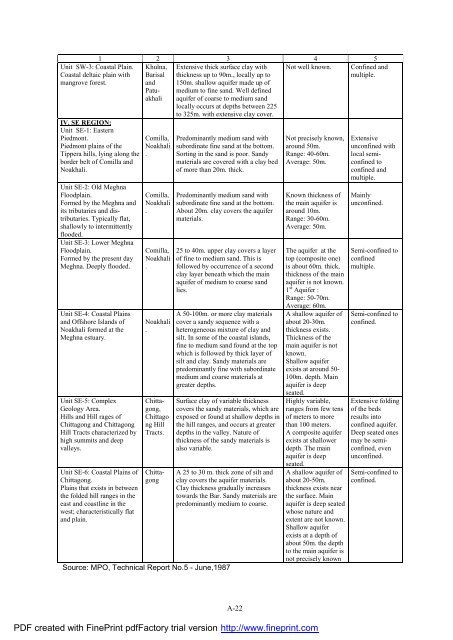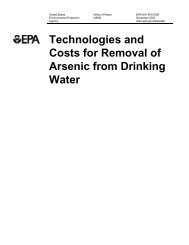Government of the People's Republic of Bangladesh Ministry of ...
Government of the People's Republic of Bangladesh Ministry of ...
Government of the People's Republic of Bangladesh Ministry of ...
Create successful ePaper yourself
Turn your PDF publications into a flip-book with our unique Google optimized e-Paper software.
Unit SW-3: Coastal Plain.<br />
Coastal deltaic plain with<br />
mangrove forest.<br />
1 2 3 4 5<br />
IV. SE REGION:<br />
Unit SE-1: Eastern<br />
Piedmont.<br />
Piedmont plains <strong>of</strong> <strong>the</strong><br />
Tippera hills, lying along <strong>the</strong><br />
border belt <strong>of</strong> Comilla and<br />
Noakhali.<br />
Unit SE-2: Old Meghna<br />
Floodplain.<br />
Formed by <strong>the</strong> Meghna and<br />
its tributaries and distributaries.<br />
Typically flat,<br />
shallowly to intermittently<br />
flooded.<br />
Unit SE-3: Lower Meghna<br />
Floodplain.<br />
Formed by <strong>the</strong> present day<br />
Meghna. Deeply flooded.<br />
Unit SE-4: Coastal Plains<br />
and Offshore Islands <strong>of</strong><br />
Noakhali formed at <strong>the</strong><br />
Meghna estuary.<br />
Unit SE-5: Complex<br />
Geology Area.<br />
Hills and Hill rages <strong>of</strong><br />
Chittagong and Chittagong<br />
Hill Tracts characterized by<br />
high summits and deep<br />
valleys.<br />
Unit SE-6: Coastal Plains <strong>of</strong><br />
Chittagong.<br />
Plains that exists in between<br />
<strong>the</strong> folded hill ranges in <strong>the</strong><br />
east and coastline in <strong>the</strong><br />
west; characteristically flat<br />
and plain.<br />
Khulna,<br />
Barisal<br />
and<br />
Patuakhali<br />
Comilla,<br />
Noakhali<br />
.<br />
Comilla,<br />
Noakhali<br />
.<br />
Comilla,<br />
Noakhali<br />
.<br />
Noakhali<br />
.<br />
Chittagong,<br />
Chittago<br />
ng Hill<br />
Tracts.<br />
Chittagong<br />
Extensive thick surface clay with<br />
thickness up to 90m., locally up to<br />
150m. shallow aquifer made up <strong>of</strong><br />
medium to fine sand. Well defined<br />
aquifer <strong>of</strong> coarse to medium sand<br />
locally occurs at depths between 225<br />
to 325m. with extensive clay cover.<br />
Predominantly medium sand with<br />
subordinate fine sand at <strong>the</strong> bottom.<br />
Sorting in <strong>the</strong> sand is poor. Sandy<br />
materials are covered with a clay bed<br />
<strong>of</strong> more than 20m. thick.<br />
Predominantly medium sand with<br />
subordinate fine sand at <strong>the</strong> bottom.<br />
About 20m. clay covers <strong>the</strong> aquifer<br />
materials.<br />
25 to 40m. upper clay covers a layer<br />
<strong>of</strong> fine to medium sand. This is<br />
followed by occurrence <strong>of</strong> a second<br />
clay layer beneath which <strong>the</strong> main<br />
aquifer <strong>of</strong> medium to coarse sand<br />
lies.<br />
A 50-100m. or more clay materials<br />
cover a sandy sequence with a<br />
heterogeneous mixture <strong>of</strong> clay and<br />
silt. In some <strong>of</strong> <strong>the</strong> coastal islands,<br />
fine to medium sand found at <strong>the</strong> top<br />
which is followed by thick layer <strong>of</strong><br />
silt and clay. Sandy materials are<br />
predominantly fine with subordinate<br />
medium and coarse materials at<br />
greater depths.<br />
Surface clay <strong>of</strong> variable thickness<br />
covers <strong>the</strong> sandy materials, which are<br />
exposed or found at shallow depths in<br />
<strong>the</strong> hill ranges, and occurs at greater<br />
depths in <strong>the</strong> valley. Nature <strong>of</strong><br />
thickness <strong>of</strong> <strong>the</strong> sandy materials is<br />
also variable.<br />
A 25 to 30 m. thick zone <strong>of</strong> silt and<br />
clay covers <strong>the</strong> aquifer materials.<br />
Clay thickness gradually increases<br />
towards <strong>the</strong> Bar. Sandy materials are<br />
predominantly medium to coarse.<br />
Source: MPO, Technical Report No.5 - June,1987<br />
A-22<br />
Not well known. Confined and<br />
multiple.<br />
Not precisely known,<br />
around 50m.<br />
Range: 40-60m.<br />
Average: 50m.<br />
Known thickness <strong>of</strong><br />
<strong>the</strong> main aquifer is<br />
around 10m.<br />
Range: 30-60m.<br />
Average: 50m.<br />
The aquifer at <strong>the</strong><br />
top (composite one)<br />
is about 60m. thick,<br />
thickness <strong>of</strong> <strong>the</strong> main<br />
aquifer is not known.<br />
1 st Aquifer :<br />
Range: 50-70m.<br />
Average: 60m.<br />
A shallow aquifer <strong>of</strong><br />
about 20-30m.<br />
thickness exists.<br />
Thickness <strong>of</strong> <strong>the</strong><br />
main aquifer is not<br />
known.<br />
Shallow aquifer<br />
exists at around 50-<br />
100m. depth. Main<br />
aquifer is deep<br />
seated.<br />
Highly variable,<br />
ranges from few tens<br />
<strong>of</strong> meters to more<br />
than 100 meters.<br />
A composite aquifer<br />
exists at shallower<br />
depth. The main<br />
aquifer is deep<br />
seated.<br />
A shallow aquifer <strong>of</strong><br />
about 20-50m.<br />
thickness exists near<br />
<strong>the</strong> surface. Main<br />
aquifer is deep seated<br />
whose nature and<br />
extent are not known.<br />
Shallow aquifer<br />
exists at a depth <strong>of</strong><br />
about 50m. <strong>the</strong> depth<br />
to <strong>the</strong> main aquifer is<br />
not precisely known<br />
PDF created with FinePrint pdfFactory trial version http://www.fineprint.com<br />
Extensive<br />
unconfined with<br />
local semiconfined<br />
to<br />
confined and<br />
multiple.<br />
Mainly<br />
unconfined.<br />
Semi-confined to<br />
confined<br />
multiple.<br />
Semi-confined to<br />
confined.<br />
Extensive folding<br />
<strong>of</strong> <strong>the</strong> beds<br />
results into<br />
confined aquifer.<br />
Deep seated ones<br />
may be semiconfined,<br />
even<br />
unconfined.<br />
Semi-confined to<br />
confined.

















